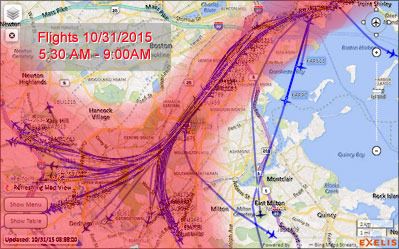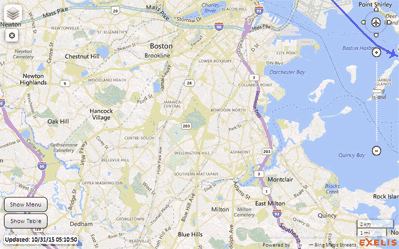The Logan Airport Flight Path and Coronary Heart Disease
If you live in the path of Logan Airport departures there's no doubt you were unable to sleep the morning of Saturday, October 31, 2015. He's a chart of the flights from about 5:30 A.M. to about 9:00.

The same data is presented here as a gif.

This week [May 15, 2015] the Federal Aviation Administration (FAA) began testing another potential noise reduction measure at Logan. According to Massport, the second test is part of the Boston Logan Airport Noise Study’s third phase, which will evaluate whether changes in runway use at Boston Logan Airport can further reduce aircraft noise in the communities surrounding the airport.
Massport supports this noise abatement effort and asked the FAA to conduct the testing. The second test is designed to evaluate whether FAA air traffic controllers can switch runway configurations at two specific points during daytime operations: after the morning peak operational period, which ends at approximately 9:30 a.m., and before the evening peak operational period, which starts at around 2:30 p.m. The test is expected to run for at least three months, but will not exceed six months.
A large-scale statistical analysis of the health effects of aircraft noise was undertaken in the late 2000s by Bernhard Greiser for the Umweltbundesamt, Germany's central environmental office. The health data of over one million residents around the Cologne airport were analysed for health effects correlating with aircraft noise. The results were then corrected for other noise influences in the residential areas, and for socioeconomic factors, to reduce possible skewing of the data.
The German study concluded that aircraft noise clearly and significantly impairs health. For example, a day-time average sound pressure level of 60 decibel increasing coronary heart disease by 61% in men and 80% in women. As another indicator, a night-time average sound pressure level of 55 decibel increased the risk of heart attacks by 66% in men and 139% in women. Statistically significant health effects did however start as early as from an average sound pressure level of 40 decibel.
Hopefully, we can convince the folks at Logan Airport who regulate flight paths to fly over the water instead of the city's densely settled neighborhoods.
Ad:

Comments
Brookline
Do they avoid Brookline for some reason? Looks very strange on the map, for all those flights heading west.
On cloudy rainy days for some
On cloudy rainy days for some reason, jet exhaust fumes are so potent in East Boston it is so easy to detect, I for one worked around airplanes at Logan Airport and I can tell the difference between jet exhaust fumes and vehicle exhaust.